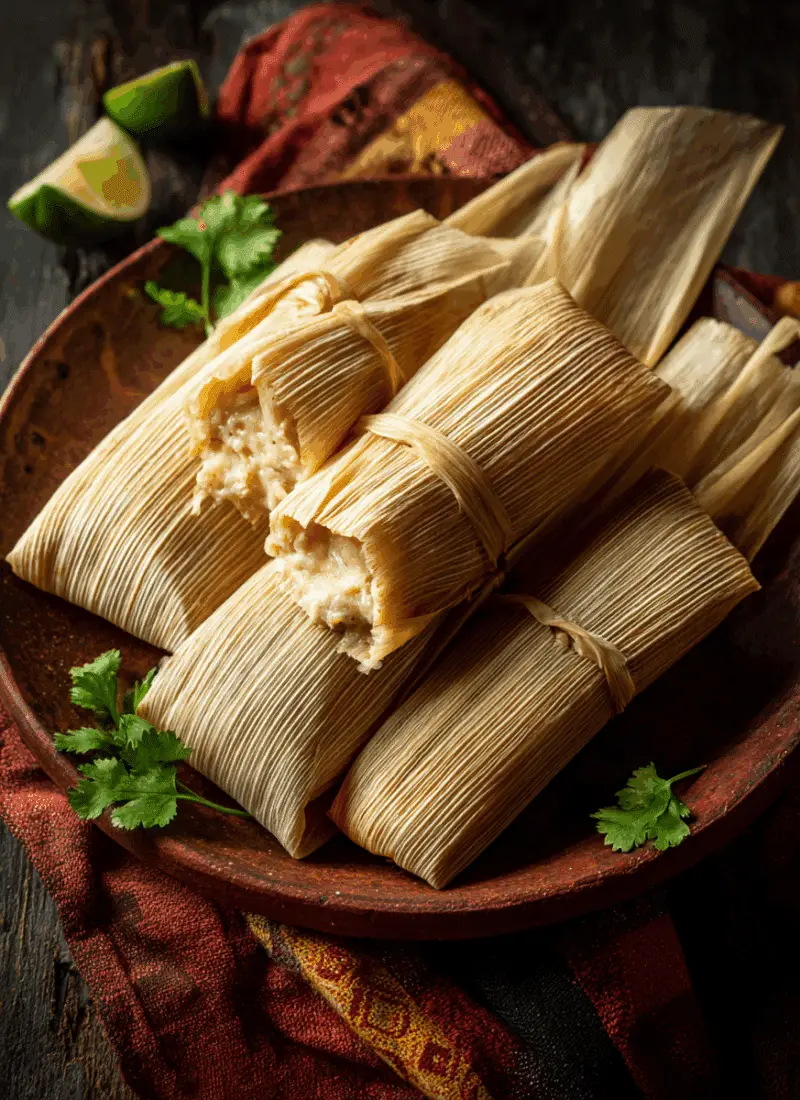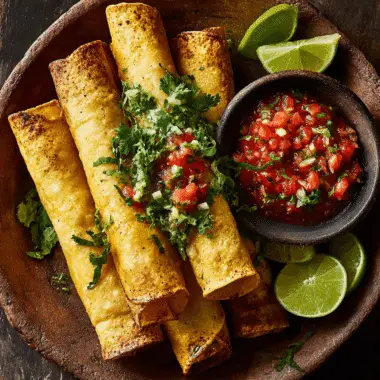Tamales are one of Mexico’s most beloved traditional dishes, especially during celebrations like Mexican Independence Day. They date back to ancient Mesoamerican civilizations, where they were prepared as portable meals for travelers and warriors. “Tamales de Elote” are made with sweet corn dough, often enjoyed as a delicacy, while pork tamales are filled with savory, spiced meat wrapped in corn husks and steamed to perfection.
FULL RECIPE
Ingredients
1.For Tamales de Elote (Sweet Corn Tamales):
- 4 cups fresh corn kernels (from about 6 large ears)
- 1 cup cornmeal (masa harina)
- ½ cup unsalted butter, softened
- ½ cup granulated sugar
- 1 teaspoon baking powder
- ½ teaspoon salt
- 1 cup whole milk
- Corn husks (soaked in warm water for 30 minutes)
2.For Pork Tamales (Savory):
- 2 lbs pork shoulder, cut into chunks
- 1 onion, quartered
- 4 cloves garlic
- 2 bay leaves
- 1 teaspoon salt
- 3 cups pork broth (reserved from cooking)
- 8 dried guajillo chiles, stemmed and seeded
- 3 dried ancho chiles, stemmed and seeded
- 1 teaspoon ground cumin
- 1 teaspoon dried oregano
- ½ teaspoon ground black pepper
- 4 cups masa harina
- 1 cup lard or vegetable shortening
- 1 teaspoon baking powder
- Corn husks (soaked in warm water for 30 minutes)
Directions
- For Tamales de Elote:
- In a blender or food processor, blend the corn kernels until smooth.
- In a large mixing bowl, cream the butter and sugar until fluffy.
- Add the corn puree, cornmeal, baking powder, and salt to the butter mixture.
- Gradually add milk while mixing until a thick batter forms.
- Take a soaked corn husk, spread about 2 tablespoons of the batter in the center, and fold the sides inward, then fold the bottom up.
- Arrange tamales upright in a steamer pot.
- Steam over medium heat for about 1 hour, or until the masa is firm and pulls away from the husk.
- For Pork Tamales:
- In a large pot, place the pork, onion, garlic, bay leaves, and salt. Cover with water and simmer until the pork is tender (about 1.5–2 hours). Reserve the broth.
- Remove the pork and shred it with forks.
- In a saucepan, simmer guajillo and ancho chiles in water for 10 minutes. Drain and blend with cumin, oregano, pepper, and 1 cup of the reserved pork broth until smooth.
- Combine shredded pork with the chile sauce in a skillet and cook for 10 minutes to allow flavors to meld.
- In a mixing bowl, beat the lard until fluffy. Add masa harina, baking powder, and 2 cups of reserved broth, mixing until a soft dough forms.
- Spread about 2 tablespoons of masa onto the center of a corn husk. Place 1–2 tablespoons of pork filling in the middle. Fold sides inward, then fold up the bottom.
- Arrange tamales upright in a steamer and steam for about 1.5 hours, or until the masa is set and separates easily from the husk.
Nutrition Facts
Tamales de Elote:
- Calories: 210
- Protein: 4g
- Fat: 9g
- Saturated Fat: 5g
- Carbohydrates: 31g
- Fiber: 3g
- Sugar: 9g
- Sodium: 180mg
Pork Tamales:
- Calories: 290
- Protein: 12g
- Fat: 14g
- Saturated Fat: 6g
- Carbohydrates: 29g
- Fiber: 4g
- Sugar: 2g
- Sodium: 300mg
Historical and Cultural Significance of Tamales de Elote and Pork
Tamales have a deep cultural history in Mexico, tracing back thousands of years to ancient civilizations like the Aztecs, Mayans, and Olmecs. These early peoples used tamales as portable meals for warriors and travelers, with fillings that varied depending on the region and available resources. Today, tamales de elote and pork tamales remain integral to Mexican celebrations, particularly during Independence Day, where they symbolize unity, tradition, and national pride. The sweet corn version highlights the country’s agricultural heritage, while the savory pork tamales showcase the complex spice blends that define Mexican cuisine.
Flavor Profile and Texture
Tamales de elote are known for their naturally sweet flavor, enhanced by the creamy texture of pureed corn and a soft, cake-like consistency when steamed. In contrast, pork tamales deliver a bold, savory taste thanks to tender, slow-cooked pork enveloped in rich chile sauce, paired with the earthy notes of masa dough. Both versions are wrapped in corn husks, which infuse a subtle aroma during steaming, adding a unique, rustic quality that’s instantly recognizable.
Nutritional Highlights
While tamales are often seen as festive indulgences, they offer a mix of essential nutrients. Tamales de elote provide dietary fiber from corn, along with moderate amounts of protein and complex carbohydrates for sustained energy. Pork tamales are protein-rich and deliver iron, zinc, and B vitamins from the pork filling, making them satisfying and nutrient-dense. Moderation is key, as both versions can be high in sodium and fats depending on preparation, but they can be adjusted for healthier versions without losing their authentic taste.
Variations Across Mexico
The diversity of tamales across Mexico is astounding, and tamales de elote and pork tamales are just two of countless variations. In Oaxaca, banana leaves replace corn husks for a distinct flavor, while in the Yucatán, achiote paste and sour orange give pork tamales a tangy, vibrant twist. In northern regions, tamales may be larger and heartier, sometimes incorporating cheese, vegetables, or other meats. Even tamales de elote have sweet and savory adaptations, such as adding cheese, cream, or a pinch of cinnamon for extra depth.
Ideal Pairings for a Complete Meal
Tamales are versatile enough to be served as a main course or as part of a larger feast. Pork tamales pair wonderfully with tangy salsas, fresh guacamole, or a crisp cabbage slaw to balance the richness of the filling. Tamales de elote are delightful with crema, fruit compote, or a drizzle of sweetened condensed milk for dessert-style enjoyment. Both versions complement Mexican beverages like atole, champurrado, or horchata, and they pair beautifully with fresh salads for a balanced plate.
Serving Tips for Maximum Enjoyment
For the best experience, tamales should be served hot, straight from the steamer, so the masa retains its tender, moist texture. When unwrapping the corn husk, take care to keep the tamal intact for a visually appealing presentation. Offering both sweet and savory varieties at the same gathering gives guests a range of flavors to enjoy. If making tamales for a party, arrange them on a platter wrapped in a clean kitchen towel to retain warmth and serve alongside multiple condiments so guests can personalize each bite.
Storage and Reheating Advice
Tamales store well, making them a great make-ahead dish. They can be refrigerated for up to five days in an airtight container or frozen for up to three months. To reheat, steaming is the preferred method to preserve their texture and moisture. If short on time, tamales can be microwaved by wrapping them in a damp paper towel to prevent drying. Frozen tamales should be thawed overnight in the refrigerator before reheating to ensure even warming.
Health-Conscious Modifications
For those aiming to make healthier tamales, several substitutions can be applied without sacrificing flavor. Using less lard or replacing it with vegetable oil reduces saturated fat, while incorporating whole-grain masa harina increases fiber content. Lean cuts of pork or even chicken can be used for the savory variety, and sweet tamales can be prepared with reduced sugar or natural sweeteners like honey. Adding vegetables to the pork filling boosts nutritional value and enhances flavor complexity.
The Role of Tamales in Festive Gatherings
Tamale-making is more than a cooking task—it’s a communal activity that brings people together. Known as a “tamalada,” the process of assembling, filling, and wrapping tamales is often done with family and friends before special occasions. This tradition fosters social bonding, passes down culinary knowledge, and creates lasting memories. During Mexican Independence Day, tamales serve as both a meal and a cultural expression, uniting generations over a shared appreciation for heritage and flavor.
Conclusion
Tamales de elote and pork tamales represent more than just delicious food—they embody the spirit of Mexican tradition, community, and culinary artistry. From their ancient origins to their modern-day adaptations, these tamales continue to hold a special place in celebrations, especially during Mexican Independence Day. Whether enjoyed for their sweet, tender corn flavor or their bold, savory pork richness, tamales offer a sensory experience that bridges past and present.








